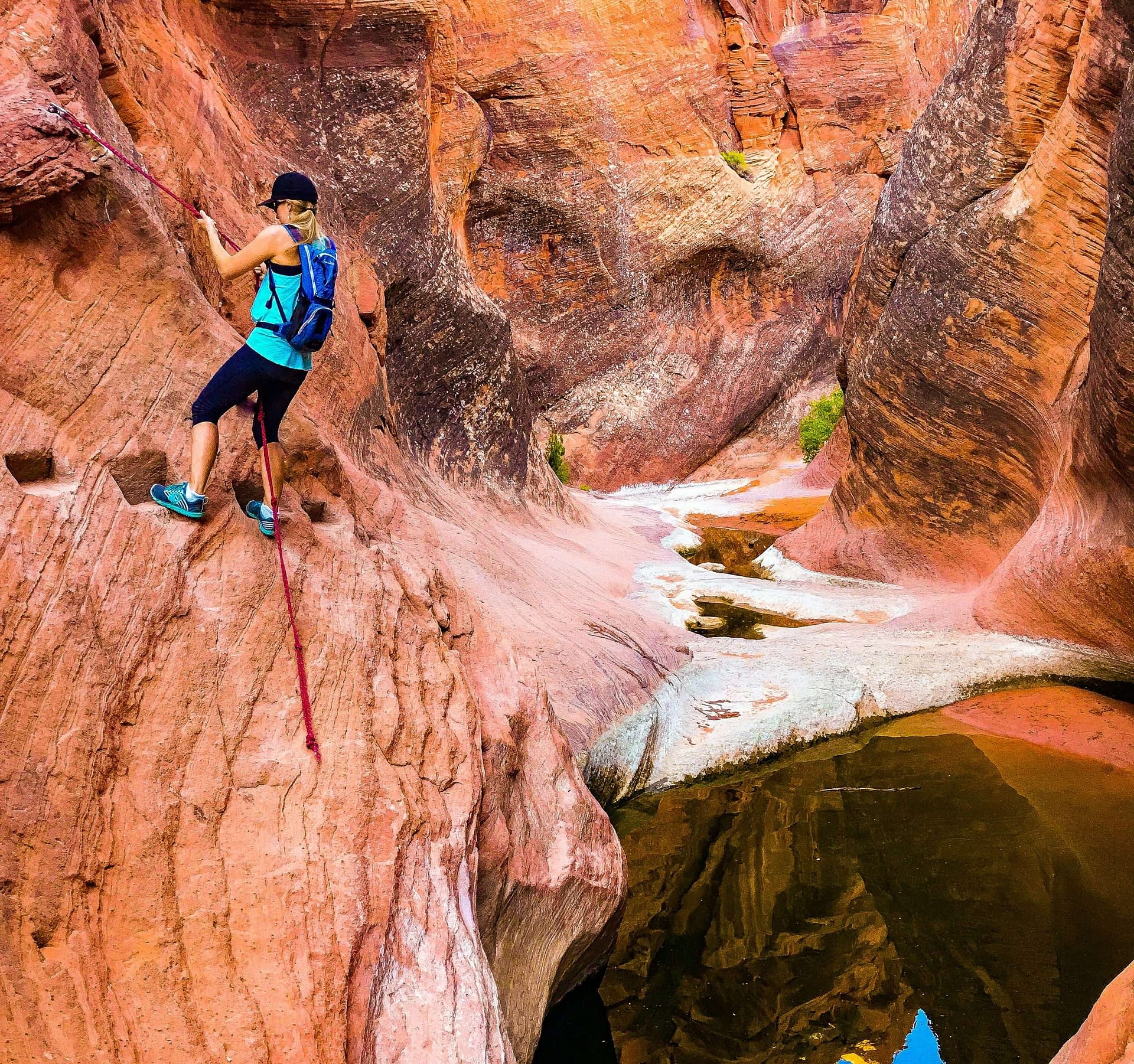
Chris’ Guide To Canyoneering
Get your descender ready
Since you’re here, you likely already know a bit (or a lot) about canyoneering. The breadth and depth of the canyoneering knowledge base is huge! If you feel intimidated by pothole escapes or building deadmen anchors, this guide is for you.
I’ve seen too many canyon parties descending canyons unprepared, unsafely, and unethically, and I want to help change that.
This guide is here to help you be more prepared for your next canyon adventure. I will teach you all the skills, knowledge, and motivation you need to get you off the couch and on rappel in your next canyon.
The guide is under development, so check back often as we add additional content.
Canyoneering Basics
I often hear people ask, what canyoneering is. Think back to your days as a kid running around the playground trying to get from one side to the other without touching the ground – climbing up slides, swinging across monkey bars, and balancing on narrow and shaky chains. It may have been a few years since you squished into the twisty slide, but you’re never too old for playgrounds because canyoneering is the grownup version of a playground.
In the most basic terms, canyoneering is descending through a canyon. Most sought-out canyons are narrow slot canyons and are often very technical in nature requiring rappelling, swimming, climbing over, under, around, and down all kinds of obstacles. Most of the canyons I’ve had the pleasure of descending are in the Southwest United States, but there are canyons all around the world in all kinds of climates.
The basic format of the ACA Canyon Rating System includes two digits. The first digit is numeric and represents the values described below related to terrain and rope work. The second digit is an alpha character representing the values described below related to water volume and current. Additional values may be added to represent relative risk and time/commitment. Ratings are cumulative.
For example: descending a Class 3 canyon will require the skills listed under Class 3, as well as those listed under Classes 1 and 2.
NOTE: Ratings refer to descents in normal conditions, during what is considered the normal season for the canyon. Adverse conditions, such as higher than normal water volume or colder temperatures, will increase the difficulty of the descent.
TERRAIN / TECHNICAL ROPE WORK
1 Canyon Hiking – Non-technical; no rope required. May involve some easy scrambling requiring the occasional use of hands for balance and support. Travel is possible up or down canyon.
2 Basic Canyoneering Scrambling, easy vertical or near-vertical climbing and/or down-climbing requiring frequent use of hands. Rope recommended for hand lines, belays, lowering packs and possible emergency use. Travel is possible up or down canyon.
3 Intermediate Canyoneering Exposed technical climbing. Down-climbing could be difficult and dangerous; most people will rappel. Rope required for belays and single-pitch rappels. Obvious natural or fixed anchors. Retreat up canyon will require ascending fixed ropes. Basic pothole escape techniques (i.e. partner assist, counterweights) may also be required. See route description for more information.
4 Advanced-Expert Canyoneering Route may involve any combination of the following: 1) difficult and exposed free climbing and/or down-climbing, 2) climbing using direct aid, 3) multi-pitch rappels, 4) complex ropework (i.e. guided rappels, deviations, rebelays), 5) obscure or indistinct natural anchors, 6) advanced problem-solving and anchor-building skills.
WATER VOLUME / CURRENT
A Normally dry or very little water. Dry falls. Water, if present, can be avoided and/or is very shallow. Shoes may get wet, but no wetsuit or drysuit required.
B Normally has water with no current or very light current. Still pools. Falls normally dry or running at a trickle. Expect to do some deep wading and/or swimming. Wetsuit or drysuit may be required depending on water and air temperatures.
C Normally has water with current. Waterfalls. Expect to do some deep wading and/or swimming in current. Wetsuit or drysuit may be required depending on water and air temperatures. Class C canyons may be rated more precisely using the following system:
C1 – Normally has water with light to moderate current. Easy water hazards.
C2 – Normally has water with strong current. Water hazards like hydraulics and siphons require advanced skills and special care.
C3 – Normally has water with very strong current. Dangerous water hazards. Experts only.
C4 – Extreme problems and hazards will be difficult to overcome, even for experienced experts with strong swimming skills.
NOTE: Water level in any canyon can fluctuate greatly from year-to-year, season-to-season, even day-to-day. If, upon arrival at a canyon, you discover the water volume/ current is greater than indicated by the rating, descent will be more difficult than suggested by the route description. It will be necessary to reevaluate your decision to attempt the descent.
RISK / SERIOUSNESS (OPTIONAL)
G General Audiences Should be straight-forward for those who possess appropriate skills.
PG Parental Guidance Suggested Even with appropriate skills, beginners may sweat.
R Risky One or more extraordinary risk factors exist that could complicate the descent. Solid technical skills and sound judgment critical. Not recommended for beginners.
X Extreme Multiple risk factors exist that will complicate the descent. Errors in technique or judgment will likely result in serious injury or death. Descent should only be attempted by expert canyoneers.
XX Double Extreme Definitely life-threatening.
NOTE: The presence of a risk/seriousness rating suggests that the canyon will involve higher than average risk. The absence or a risk/seriousness rating does not suggest that there will be no risk. All canyoneering involves risk. Risk factors include number and frequency of rappels, length of rappels (single- or double-rope) and exposure, anchor availability, anchor quality, route finding, obstacles, problem-solving, terrain encountered between technical sections, flash flood potential, availability of exits and high ground, water temperature, prolonged immersion, and difficulty of evacuation or rescue. Specific factors should be addressed in the route description.
TIME / COMMITMENT (OPTIONAL)
Half Day
I Short. Normally requires only a couple of hours.
II Normally requires a half day.
Full Day
III Normally requires most of a day.
IV Expected to take one long, full day. Get an early start. Bring a head lamp. Plan for possible bivy.
Multi-Day
V Expected to take an average one and a half days.
VI Expected to take two or more days.
NOTE: Time estimates are based on average group of 6 people or less. Larger groups and less experienced groups will take longer. An accurate self-assessment of your abilities will be important. For some users, it may be adequate to refer to time in terms of half day, full day or multi day. Others may prefer a more specific estimate and choose to use the Roman Numeral Grade system common in traditional multi-pitch rock climbing.
S = SLOT DESIGNATION
Tight slot canyons are in a class of their own. Slots can be so narrow that it is necessary to stem above the floor of the canyon to move horizontally. An “S” may be appended to the terrain rating to indicate some sections of the canyon are extremely narrow. A canyon rated S2 will serve as a warning to those with greater-than-average girth that they may have to stem more than their skinny partners. A canyon rated S6 will draw emphasize the need to execute difficult climbing/stemming moves that are likely to be high above the canyon floor.
– Rappelling
– Anchor building
– Navigation
– Pothole escapes
– Down climbing
– Ascending
– Class C technique
How to rappel
Rappelling, just like so many other skills, is highly situational. The principles applied will always be the same, but the actual steps or procedures used will look different in every unique situation. Judging the terrain, skills of the team, weather, equipment, and other variables will dictate how to rig and execute a rappel. We won’t go over every nuance of rappelling here, but we’ll cover the main principles that – if followed – will greatly reduce your risk of becoming a rappelling statistic.
Let’s jump in at the top of a cliff. Whether we got here by climbing up from below or are lowering down, the same general sequence will apply.
Here’s a video I made of a canyoneering sequence you may see in canyoneering.
How to perform a fireman’s belay
A properly performed fireman’s belay is a reliable way to stay safe while on rappel. It takes two people with one at the bottom of the rappel.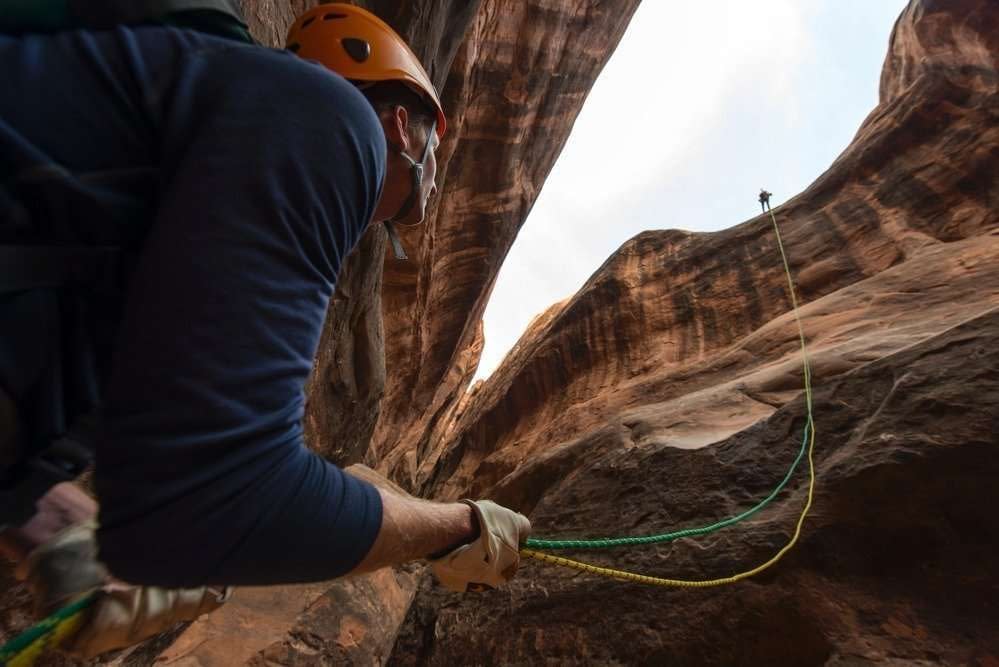 Rappelling with an attentive fireman belayer. He could improve by extending his arms out further.
Rappelling with an attentive fireman belayer. He could improve by extending his arms out further.
The belayer at the bottom holds the rappel rope(s) while standing close to, but not directly under the rappeller’s fall line. If at any point the rappeller loses control, the belayer can simply pull the ropes tight and lock the rope at the rappeller’s belay device arresting a fall.
I see fireman’s belays performed frequently and most times they’re not done properly. A proper fireman’s belay requires that the belayer is under the rappeler so the angle of pull on the rope will lock the belay device. The belayer should also be in a protected position to avoid rockfall. This may be accomplished by stepping a foot or two to the side or back from the fall line. As rocks and debris often fall during a rappel, the belayer must have a helmet on and stay attentive throughout the rappel.
The rope should be loose enough to allow the rappeller to control her movement, but tight enough that a good tug on the rope from the belayer would lock the belay device. It’s easier to lock the rope tight if the belayer is standing and has her arms extended out so there’s more room to take in slack.
Read more about why I always wear my helmet while climbing or rappelling.
The belayer should be ready to pull down on the rope at a moment’s notice as accidents can happen very quickly.
Safety check the system before rappelling
Now that you’ve got the rappel rigged properly with a backup in place, it’s time to check the system before you launch off. Ideally, you’ll do a partner check, but often when rappelling you’re the only one at the rappel station so performing a self-check becomes necessary.
Never skip the safety check step as it’s too easy to get complacent and forget a step. Too many accidents could have been avoided had a team done a simple safety check.
I like to use the acronym CHECK for my safety check.
C – Clothing
Ensure your clothing isn’t loose and liable to get stuck in a belay device or get in your way while you’re rappelling. Hoodie strings, sleeves, shirttails, or necklaces can all get sucked into belay devices and while on rappel, that spells trouble. Tuck them in, tie them off, or take them off before rappelling. If you have a backpack, clip it to a sling from your harness and hang it between your legs for the rappel. If you’re too topheavy, you risk flipping upsidedown.
H – Helmet, Harness, Hands, Hair (that’s a lot of H words!)
Check your helmet to ensure it’s on and fastened. Ensure your harness is on correctly including doubled back if it needs to be. Check your hands. Did you put on your rappelling gloves? Check your hair. Long hair can get stuck in a belay device. Tie it back.
E – Environment
Check the environment for things like excess noise, wind, sun exposure, weather threats, animals, other climbing groups, etc. I like to take a final inventory of my gear to ensure I’m not leaving anything behind. This one covers a general risk assessment of anything that could interfere with a safe rappel.
C – Connections
Check all your carabiners or other connections to ensure they’re locked, not cross-loaded, or otherwise at risk of not working properly.
K – Knots
Check all the knots in the system including the prusik and anchor knots.
When running through the CHECK process, partners should check each other. It’s easy for people to get complacent and not check that the rope from the belay device goes properly through the carabiner. That’s when bad stuff happens!
Other safety skills you’ll want to learn as you get some experience with the basics are listed here but I won’t cover them in detail in this article.
Passing a knot
Ascending and load transfer
Rigging a releasable rappel
After you’ve completed a thorough safety check, it’s time to test the system.
Test the rappel system
At this point you should still be safely tethered to the anchor with your personal protection. With this connection, you can safely test the rappel rigging to see if you overlooked anything. Do this by choking your belay device as close to the anchor as you can and fully weighting the rappel rope. Let the rappel rope slide through the belay device freely until the prusik locks tight.
If everything is rigged properly, you should be able to weight the rappel rope, the anchor, your harness, and the prusik all without any issue and you’re ready to go live.
Beginning the rappel
If you have a fireman belay, call out “On belay?” and wait for the response “Belay on!”. Once confirmed that you’re on belay, you can safely remove your personal protection. Be sure to keep one hand firmly holding the brake strand throughout the rappel start.
Once your protection is removed and you’re in position to rappel, call out “On rappel”. I have a habit of doing this vocally even when I’m rappelling alone. It’s just part of my routine now.
Learn more about climbing commands in this article: Belaying: Everything A Beginner Needs To Know – Don’t Let Go Of The Rope!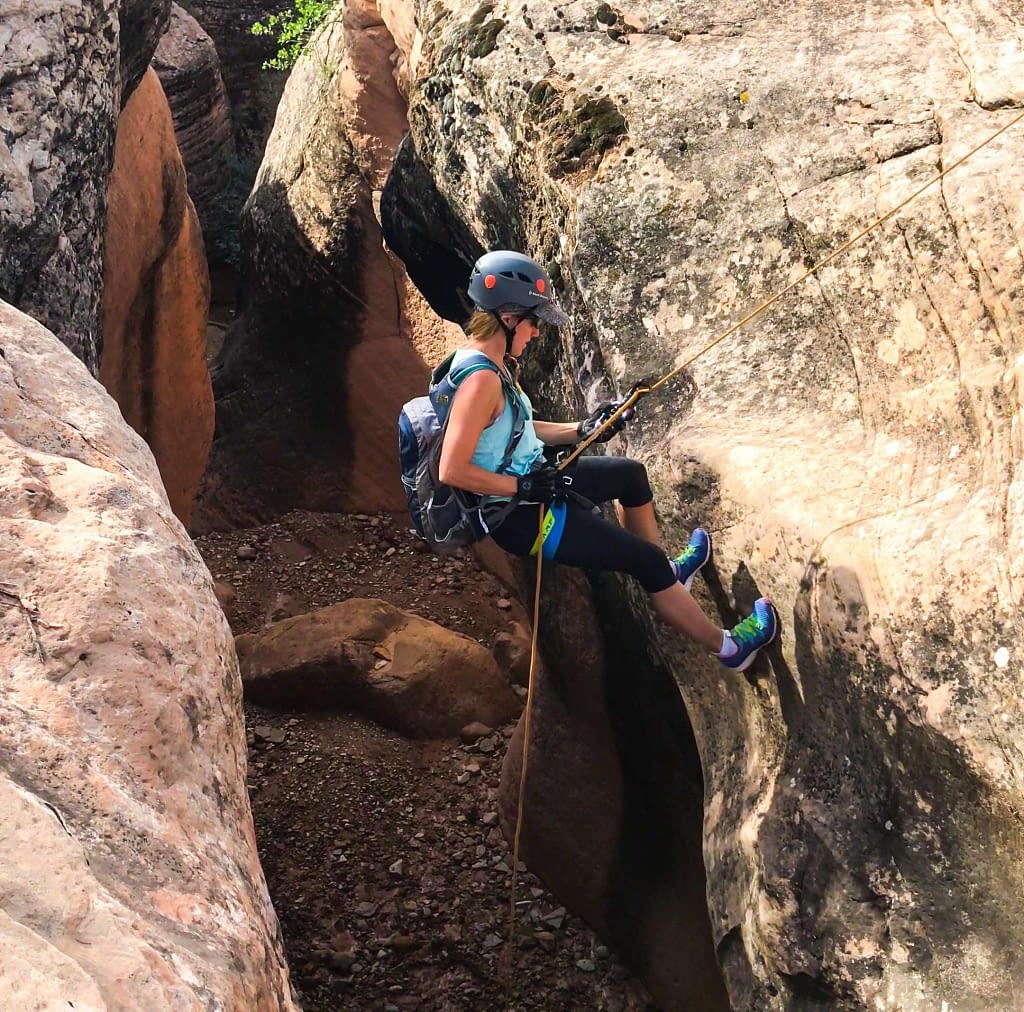 Alicia walking down over the edge to start her rappel into this canyon
Alicia walking down over the edge to start her rappel into this canyon
As you begin the rappel, sit back into the harness and gradually walk back toward the edge of the cliff.
On rappel
Usually, the most exhilarating part of rappelling is the start. If you’re lucky and you have a good sloping start with a high anchor, it’s not at all challenging to just walk backward as you weight the harness keeping your feet shoulder-width apart.
Challenging starts
More often than not, you won’t have a perfect start to your rappel. Sometimes you’ll have anchors right on the edge of the cliff or even down on the face of the cliff. You may have an overhanging start. It’s not going to work to simply walk off the edge in these cases. Each scenario is different, but you can make any start easier by choking up as close to the anchor point as possible. This may require that you sit on your butt or downclimb a bit to get a stance on the face of the cliff. Just don’t let go of the brake strand!
If you’re facing an overhanging or sharp edge, sit on the edge and slowly roll on your hips until you’re hanging on the rope. This can be pretty awkward, so don’t expect to have a graceful start on every rappel. Alicia rolling on her hip into an awkward rappel start
Alicia rolling on her hip into an awkward rappel start
Hard starts can also pose a risk to the anchor and the rope. As you drop over the edge, be watchful of what impact your movements will have on the rope and anchor system. Do what you can to avoid shock loading the anchor or dropping the rope roughly onto a sharp edge. Move slowly and also keep an eye on your hands as its easy to pinch them between the rope and the rock.
Keep it smooth Alicia moving smoothly and keeping an eye on where she steps
Alicia moving smoothly and keeping an eye on where she steps
Once you’re beyond the start and have a good rappelling stance, keep your eyes looking down so you can anticipate and avoid any obstacles along the rappel. Move steadily but smoothly down the wall. You may see people bounding down the wall in huge leaps, but this is terrible rappelling form. It adds unnecessary stress to the system and puts you in less control of your descent.
Be mindful of the friction on your rope. If you’re moving too fast, work to get the rope back further so it’s in line with the rappelling rope above you.
Adding friction
Wet or skinny ropes, especially on single-strand rappels, will require more friction, so plan for this in advance.
Read a trip report where I was on a wet, icy, single rope rappel: Donut Falls Rappel – Trip Report
You can add more friction to your system with a couple of carabiners by clipping one to your belay loop and the other to the belay carabiner and running the brake strand through the belay loop biner and then through the carabiner hooked to the belay device carabiner. This can be done while on rappel if you have the carabiners handy.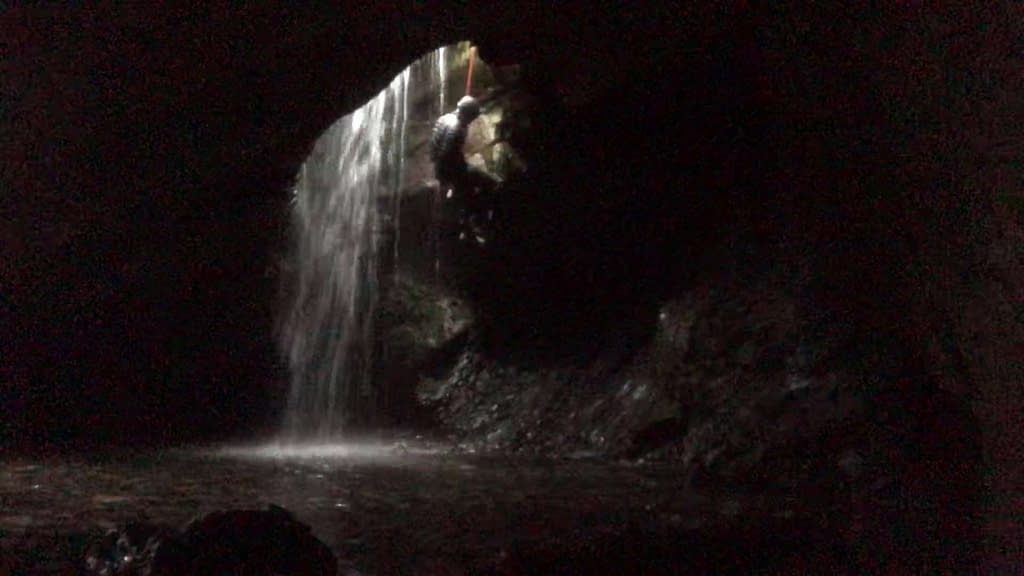 Me rappelling into an underground waterfall chamber keeping an eye on the friction on the wet and icy rope
Me rappelling into an underground waterfall chamber keeping an eye on the friction on the wet and icy rope
Watch for your landing
As you progress down the wall, keep an eye out for your landing spot. Whether on the ground or at the next belay station, you should be paying attention to where you want to end up. Watch for the ends of the rope so you don’t get hung up on the knots or land in an awkward place.
Once you reach your landing you can get stable footing under you if you’re on the ground or set up an anchor if you’re doing a multi-pitch. Once you’re secure, remove your prusik and the belay device from the rope and call out “Off rappel!” so the rest of the party knows what to do next.
A note on unclipping your rappel device either at the start or the end of a rappel. DO NOT DROP IT. It’s easy to let that little thing slip out of your hands and leave you hanging – er – unable to hang. If you find yourself in that predicament, you’ll be happy to know how to use the munter hitch.
So that’s the general sequence and process of rappelling. Of course, the myriad circumstances you find yourself needing to rappel will change this up a bit, but follow the principles outlined here and you’ll stay safe.
Here are a few additional considerations to help you make better decisions in various scenarios.
Courtesy
Ghost
Redundancy
Webbing knots
Bolted anchors
Existing webbing inspection
Setting up the anchor
Before you step up to the edge of the cliff, rig a safety tether to avoid mishaps at the cliff’s edge.
Safety tether
To safely rappel you’ll need to construct an anchor. This often requires you to get too close to the edge for comfort. Accidents can easily happen at the top of cliffs while rigging anchors. The easy way to avoid this is by rigging a safety tether.
To rig a safety tether, simply find a secure object, such as a tree or a rock, or maybe even another person positioned well away from the edge of the cliff. Tie a length of rope or webbing around the object and secure the other end to your harness using a personal anchor system so you can get right up to the edge of the cliff without falling off.
With this safety tether, you can now work safely on the edge of the cliff to build your rappelling anchor without risking a misstep that could end your day in a bad way.
Construct the rappelling anchor![]() A strong, secure, and simple anchor ready for rappelling
A strong, secure, and simple anchor ready for rappelling
To get down the canyon you’ll need an anchor. Canyoneering anchors aren’t the same as rock climbing anchors, so read on to learn how to build canyoneering anchors.
Anchor building is a complete skill in and of itself that we won’t spend too much time on here. The principles of anchor building that will keep you safe rappelling is that an anchor must be strong, secure, and simple. It’s easier to start a rappel if the anchor is positioned above your waist and a bit back from the edge of the cliff.
If you’ll need to pull the rope once you get to the bottom consider how the anchor position will impact your ability to pull the rope. Is the rope going to drag or will you have a clean pull? It’s better to have a hard start than it is to not be able to retrieve your rope.
Once you get the anchor securely built, you can clip your personal protection to the anchor and remove the safety tether.
SRT
DRT
Contingency
Releasable
LAPAR
Rig your rope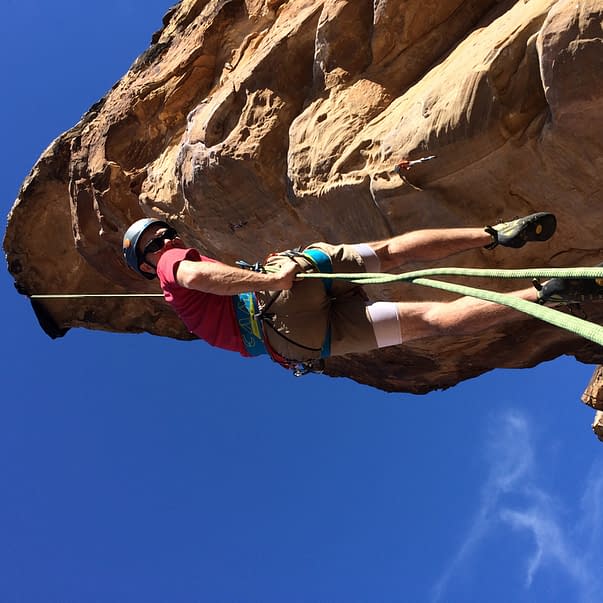 Double-stranded rappel
Double-stranded rappel
Once you have a strong, secure, and simple anchor rigged, you can set up your rope for the rappel.
Depending on what activity you’re doing, (mountaineering, canyoneering, etc.) the rappelling scenarios will look a bit different. For rock climbing, the most common scenario will be that you’re rappelling to the ground from the top of a route or you’re rappelling down a multi-pitch climb one pitch at a time.
For these scenarios, you’ll most frequently be using a double-stranded rappel so we’ll discuss that scenario in detail. Plenty of other scenarios exist and although the details are different, the same general principles apply.
To rig your rope for rappelling, connect the rope to the anchor at the middle point of the rope or run it through the chains until at the midpoint. It helps to have your rope marked at the middle for this. Once you find the middle you can use chalk to mark it if you have multiple raps to complete. If both ends of the rope are visibly touching the ground, you don’t need to find the exact middle. Rope rigged for rappelling
Rope rigged for rappelling
Tie a knot in the tails of the rope
If you’re unsure that both ends are touching the ground or if you’re rappelling to the next anchor station on a multi-pitch, tie a knot in each end of the rope. I like to tie a figure eight on a bight with at least a 4-inch tail. I like to leave a much longer tail after these knots if I have enough rope so that there’s rope to work with if something isn’t right at the landing.
This knot ensures you don’t rappel off the end of the rope. Many unfortunate scenarios have resulted from climbers not tying knots in the end of their rappel ropes. Don’t become one of them.
Rope Management
To complete a successful rappel, you’ll need both sides of the rope to drop cleanly down to the ground or next anchor station. Ensure as you rig your rope that there are no knots, tangles, or other obstructions preventing a clean rappel from top to bottom. If you hit a knot while rappelling you’ll end up wasting more time and energy fixing it while on rappel than if you fixed it before starting.
In windy conditions, ropes can blow around and snag on various features. It’s usually better in windy conditions to saddlebag the rope as you descend or to lower the rope down from above rather than throwing it. Some people connect the ends of the rope to their harness so the rope doesn’t blow around and get stuck.
Once you get your rope rigged through the anchor and have both ends touching the ground or tied off, it’s time to connect the rappel device to the rope.
Rigging the rappel device
Setting up your rappel device before you let gravity take over is simple, but if not done perfectly, it can lead to trouble. Gravity doesn’t discriminate. It’s trying to kill all of us
If you’re performing a double rope rappel, pick up both sides of the rope and give yourself a few feet of slack. On long rappels, the rope can be quite heavy so I like to gently pinch the rope against the ground with my foot to hold the weight (there’s always an exception and this may be the only exception to the not stepping on the rope rule).
With your belay device properly connected to your belay loop with a locking carabiner, take bights of both ropes in your hand and push the ropes through the slots on your belay device.
Clip both bights of rope through the carabiner and lock the carabiner.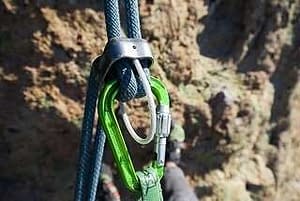 belay device loaded for a double strand rappel
belay device loaded for a double strand rappel
Depending on what type of belay device you’re using, these instructions may vary. Be sure to read and understand the instructions for rigging whatever belay device you use.
Backing up your rappel
Because risk abounds in the vertical world, we do all we can to mitigate it. One risk to consider is that when on rappel, the only thing keeping you from plummeting to the ground is your firm hold on the brake rope. Many situations could cause you to lose control of the brake line so wisdom dictates that we build in some redundancy here.
I’ll tell you straight up that there are no perfect ways to back up a rappel, but there are a few that are tried and true. We’ll start with the prusik or “third hand”.
How to rig a prusik or autoblock backup
A prusik is small loop of 5-7mm cord tied with a double fisherman’s bend. You can buy these presewn as well.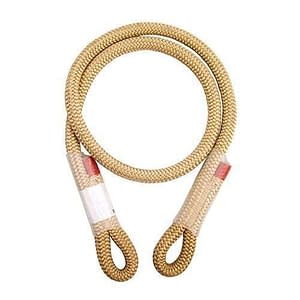 Buy on Amazon
Buy on Amazon
With a carabiner clipped to the belay loop, you’ll rig the prusik or autoblock below the belay device on the brake strand of rope. The belay device should be adequately extended to ensure the autoblock or prusik doesn’t get close to the belay device or the autoblock won’t work.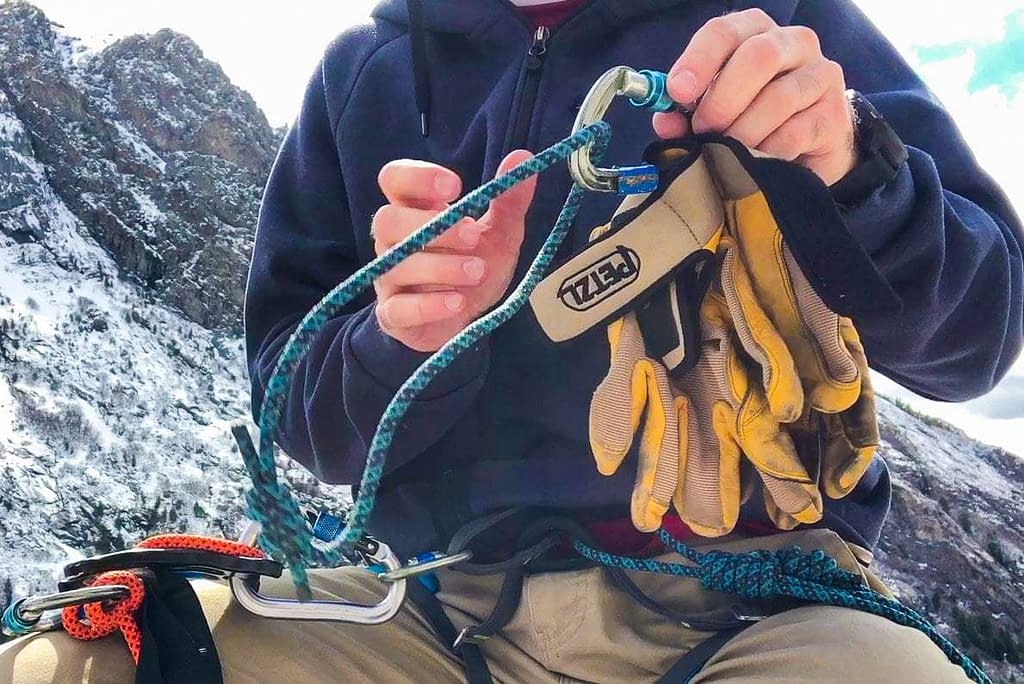 My small Prusik loop
My small Prusik loop
Start by clipping the prusik loop to the carabiner and then wrap it several times around the brake strand of the climbing rope. This will work for double or single strand rappels. Be sure the wraps are neat and organized with each one stacked on top of the others. Sloppy prusiks don’t work properly.
Clip the loop back to the carabiner and lock the carabiner.
Put some weight on the rope to extend the prusik. At full extension, the prusik should lock on the rope and hold your weight and should not be too close to the belay device. If your prusik isn’t fully locking you need to add more wraps. If your prusik is within a few inches of the belay device, you need a shorter prusik or you need to extend the belay rigging.
Learn how to extend a rappel here
Rigging a prusik is not something you should be doing for the first time at the top of a rappel. This should be all figured out at home or at camp. Prusiks can be finicky but properly configuring the length of your loop for the rope you’ll be using both in double and single strand setups will save you time and give you confidence when you’re out on the wall.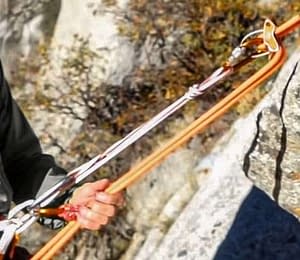 An extended belay with a prusik backup
An extended belay with a prusik backup
With the prusik in place, you have redundancy in your brake hand. If you happen to let go or lose control, the prusik will lock on the rope and prevent catastrophe. Prusiks aren’t the only method to back up your rappel. A much simpler and reliable backup is the fireman’s belay. I only use the prusik or autoblock if I’m the first person down the rappel. All other times, I use a fireman’s belay.
Use releasable rigging
Releasable rigging should be used whenever possible and especially with anyone not proficient in performing self-rescue while on the rope. It takes a bit more skill and thought, but it really doesn’t take much more time if you plan on releasable rigging to begin with.
My preferred setup is the munter mule overhand, but many other options exist. The key is to learn one, practice it, and use it regularly. Munter mule overhand releasable rigging
Munter mule overhand releasable rigging
Extend the belay device
Especially with those who haven’t spent much time dangling from a harness over the edge of a cliff, extending a belay device can make rappelling much more comfortable by preventing flipping upsidedown and prevent hair, clothing, or fingers getting sucked into belay devices. It also makes it easier to create friction since you have more space to move the rope back behind the belay device. If you’re using a prusik, extended belays will also give you more wiggle room on the size of your prusik loop.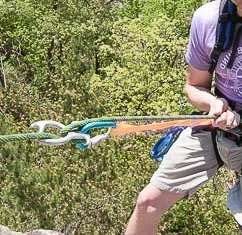 Extended belay device
Extended belay device
To extend the belay, you simply connect a sling, draw, or other fall-rated material to your harness belay loop or hardpoints and attach the carabiner and belay device to the extension. It’s essentially creating a new and bigger belay loop.
Read: The extended rappel: learn this skill for safer, easier rappelling
Recent Articles on Canyoneering
⛈️How to avoid flash floods in slot canyons
🏕️wilderness survival kit: what to pack
Gata Media – Canyoneering in Costa Rica – Trip Report
Heatstroke is deadly: Learn to recognize, prevent and treat it
The Extended Rappel: learn this skill for safer, easier rappelling
Blisters: Learn to prevent and treat these painful adventure-killers
Additional canyoneering resources I use all the time
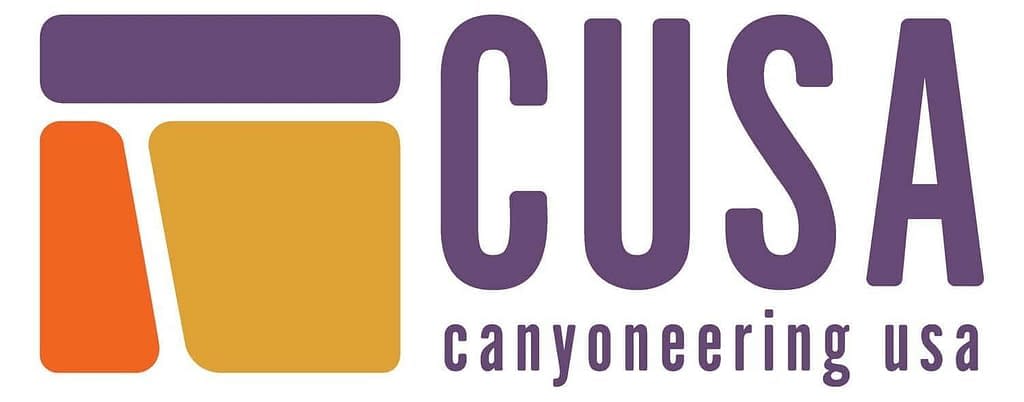
Canyoneering USA is a great resource for anyone wanting to get into Canyoneering, especially in Zion National Park. Tom Jones is one of the grandfathers of the canyoneering community and a great wealth of wisdom.

Road Trip Ryan is a fabulous resource for canyon beta. Ryan Cornia is adding more canyons (and other adventures) all the time. If you want to get more details you have to join the mailing list, but it’s worth it.

BluuGnome.com is a great resource for beta, maps, and technical info. They also have a store to buy some gear.

Canyon Collective is a forum site where canyoneers can share trip reports, discuss technical skills, and generally geek out about canyoneering.

The American Canyoneering Association This site is run by Rich Carlson – the father of modern canyoneering. The ACA provides certification courses in canyoneering for all levels. They also schedule rendezvous and other events.

Candition.com is a valuable resource for planning a trip. You can get recent canyon conditions and share your own observations for others.

Canyons & Crags is another Rich Carlson site. You can read about his adventures here as well as sign up for training courses, or read the knowledge base.
Useful Canyoneering Products
-
 1 inch Nylon Tubular Webbing$19.95
1 inch Nylon Tubular Webbing$19.95 -
Sale Product on sale
 7mm Sewn Prusik Loop
7mm Sewn Prusik Loop$16.95Original price was: $16.95.$15.67Current price is: $15.67. -
 Dyneema Sling
Dyneema Sling -
 Quickdraw Sling
Quickdraw Sling -
 Rocklock Screwgate Carabiner$14.95
Rocklock Screwgate Carabiner$14.95











